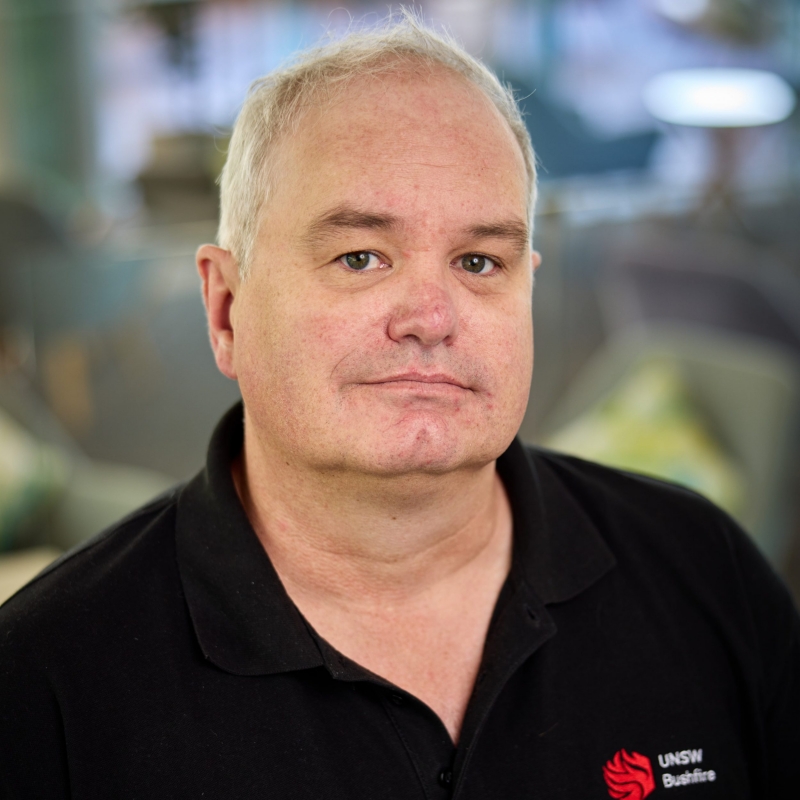Professor Jason Sharples
University of New South Wales
Mr William Swedosh
CSIRO Data61/University of New South Wales
Mathematical Modelling of Bushfires
This short course introduces students to the mathematical concepts underlying the behaviour and propagation of bushfires. It explores how environmental factors such as wind, terrain, and fuel conditions influence fire dynamics, and how these are incorporated into mathematical frameworks to predict bushfire spread and intensity. The course also highlights the use of advanced modelling techniques and real-world applications in fire management and emergency response.
By the end of the course, participants will:
- Understand the role of mathematical modelling in predicting the propagation of bushfires.
- Be familiar with the ways that different environmental factors are used to predict fire spread.
- Be able to implement basic fire spread models under idealised conditions.
- Understand the mathematical underpinnings of Australia’s national bushfire simulator.
Topics:
- Introduction to Bushfire Behaviour
- Bushfire Spread Modelling
- Effects of Wind and Topography
- Elliptical Fire Spread and Geometric Models
- Level Set Methods and Computational Tools
NOTE: Tutorial 1 on Wednesday 3 September is an in-person tour of a nearby site where a bushfire has recently occurred. Participants will see real-world examples of some of the fire behaviour characteristics discussed in Lecture 1.
Relevance
Bushfires are a significant natural hazard in Australia and globally. Mathematical modelling plays a crucial role in: Predicting fire spread and intensity; Supporting emergency response and evacuation planning; Designing fire mitigation strategies; Advancing scientific understanding of fire dynamics. This course is ideal for students and researchers in applied mathematics, environmental science, physics, engineering, and computational modelling, as well as professionals in emergency services and land management.
Pre-requisites
This course is designed to be accessible to participants from diverse disciplinary backgrounds. While no advanced mathematical training is required, participants are expected to have:
- A solid foundation in calculus and linear algebra
- Basic familiarity with partial differential equations
- Basic understanding of numerical methods
- Experience with scientific computing (e.g. MATLAB, Python)
- An interest in applying mathematics to real-world environmental problems
While mathematical concepts will be explored in the context of bushfire spread prediction, no prior knowledge of bushfire science is required.
Pre-Reading
No pre-reading is necessary to prepare for the course, but students are encouraged to review:
- Sullivan, A.L., 2009. Wildland surface fire spread modelling, 1990–2007. 2: Empirical and quasi-empirical models. International Journal of Wildland Fire, 18(4), pp.369-386.
https://doi.org/10.1071/WF06142 - Rothermel, R.C., 1972. A mathematical model for predicting fire spread in wildland fuels (Vol. 115). Intermountain Forest & Range Experiment Station, Forest Service, US Department of Agriculture.
https://www.fs.usda.gov/rm/pubs_int/int_rp115.pdf
Introductory chapters from any standard text on mathematical modelling in the physical or environmental sciences

Professor Jason Sharples
University of New South Wales
Professor Jason Sharples is an internationally recognised authority in dynamic bushfire behaviour and extreme bushfire development, whose pioneering research has extensively influenced both policy and practice in Australia and internationally. As an expert advisor and witness to the NSW Independent Bushfire Inquiry following the 2019-20 Black Summer fires, the resulting recommendations are framed by Sharples’ research. He has extensive experience in practice-led bushfire research, close engagement with government and the emergency services industry, and broad community outreach.

Mr Will Swedosh
CSIRO Data61 & University of New South Wales
William graduated Monash University in 2012 with a Bachelor of Science (Applied Mathematics and Physics) and Bachelor of Engineering (Mechanical) with Honours (H1).
William worked as a consulting engineer for two years in the offshore and mining industries where he spent time in a marine and infrastructure team, structural engineering team and system safety team in Melbourne, and 3 months working in the Houston, Texas office. Here William developed skills in programming, modelling, project management and research through working on many multidisciplinary projects.
From 2015 to 2020, William worked as a computational modeller at CSIRO Data61 within the Natural Hazards team, predominantly in the bushfire space. Here, William mainly developed, tested and used Spark – CSIROs wildfire modelling software, as well as contributing to research in the wildfire modelling space.
From 2020 to 2022, William was part of the Bushfire Adaptation team where he focussed on the impact of bushfires on people and the built environment, from the household scale to the creation of state-wide and national bushfire potential maps.
Since July 2022, William has been part of CSIRO Data61 where he is again working on Spark and helping it become Australia’s new national fire spread simulator.
